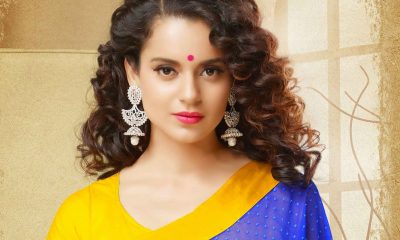Life Style
How to buy saris in India

Every state across India has its own special weaves and fabrics for its saris. One of the most popular and traditional types of saris is the Kanchipuram/Kanjeevaram, from south India. Here is a guide on how to buy saris
The ancient and exotic sari, India’s traditional national dress for women, has withstood the test of time and is now over 5,000 years old. For those who’ve never put one on, a sari can be a bit of a mystery with its many pleats and folds. However, a visit to India wouldn’t be complete without at least trying one! This information will help you with sari shopping in India.
What is a Sari?
A sari is simply a long length of fabric, typically six to nine yards, that’s worn elegantly wrapped around the body. In this regard, one size truly fits all. One end of the material is richly decorated, and is called the pallu. It’s usually worn pleated and pinned over the shoulder, draping down the back. It can also be worn open over the shoulder and draped over the arm.
A special blouse that bares the midriff, called a choli, and a petticoat are worn under the sari. As the sari is wrapped around the body, the material is tucked tightly into the petticoat so it doesn’t fall down.
No pins are needed, although it is common to use them. Cholis can be purchased separately, although quality saris do come with an attached piece of blouse material. This is taken to a tailor who will hem the sari and make the blouse to size in a couple of days.
What Different Types of Saris are Available
Every state across India has its own special weaves and fabrics for its saris. One of the most popular and traditional types of saris is the Kanchipuram/Kanjeevaram, from south India. This sari is made out of heavy silk material and has broad decorative borders and contrasting colors. Many of the patterns are derived from temples, palaces and paintings.
Another popular type of sari is the Banarasi sari, which is hand woven in Banaras (also known as Varanasi). These saris became fashionable way back when the Moguls ruled India, and they exhibit patterns from this era. Banarasi saris are admired for their eye catching, colorful dyed silk fabric. Many feature designs of villages, flowers, and temples.
Other well known types of saris include the bright tie-dyed Bandhani/Bandhej saris from Rajasthan and Gujarat, cotton Gadhwal saris with silk borders and pallu from Andhra Pradesh, Maheshwari saris from Madhya Pradesh, and the gorgeous fine silk and gold woven Paithani saris with peacock design from Maharashtra.
A notable feature of most saris is the zari (gold thread) work in them. This fine gold thread is woven throughout the sari, but appears mostly on the borders and pallu. The zari itself traditionally comes from Surat, in the state of Gujarat.
What is the Cost of a Sari
It’s possible to pick up a cheap sari for only 150 rupees, however you’ll need to be prepared to pay much more to get a quality item. Purchasing a beautiful sari in India is still inexpensive compared to Western prices though.
The main thing that affects the price of a sari is the type of fabric that it’s made out of. Plain printed silk saris are available from 1,500 rupees. Any sari that has thread work woven into it will cost more, with the price increasing in proportion to the amount of the thread work. If the sari also has zari in it, the cost will be higher again. Another factor influencing the price of a sari is the amount and type of embroidery on it, such as around the border. Saris that have lots of hand stitched decoration on them will cost more.
You should expect to pay at least 6,000 rupees for a decent and authentic Kanchipuram sari, although imitation ones can cost as little as 750 rupees. Good quality Banarasi saris start from around 2,000 rupees. The simplest exquisite Paithani sari is not cheap, and begins at around 10,000 rupees. Bandhani saris are much more affordable, from 1,000 rupees.
As far as upper price limits go for saris, the amount can easily extend to 50,000 rupees or more.
Choosing the Right Sari for the Occasion
Something you must keep in mind when choosing a sari is where you intend to wear it. The type of fabric, color, design or pattern, and embroidery are all important considerations. Just like it would be appropriate to wear chiffon or silk to a formal event, and cotton during the day, when dressing in western clothing the same goes for wearing a sari. If you’re buying a sari to wear to a festival or wedding ceremony, a traditional silk sari is a good choice. For a wedding reception, chiffon, georgette or net saris are popular, with plenty of embroidery and bling! The cut of the blouse also varies. The blouse for an evening wear sari will have shorter sleeves and will be low cut at the back.
If you’re serious about making an impression when wearing a sari, don’t neglect your jewelry! It’s important to accessorize the sari properly, so buy matching bangles as well as a matching jewelry set (necklace and earrings).
What to Be Careful of When Buying a Sari
Lots of places offer imitation saris with copies of Kanjeevaram and other patterns. The most important thing to check is the quality of the silk and zari in the sari. On initial inspection, the silk may feel thick and glossy near the pallu but inside the sari, you may find that it’s half the thickness! Manufacturers of lesser quality saris use two-ply silk instead of three-ply for weaving, and fake gold thread for the zari work.
The zari used for a Kanjeevaram sari is a silk thread covered with flattened silver in the center, and gold on the outer surface. To test whether the zari is fake, scratch or scrape it and if red silk doesn’t emerge from the core, the sari is not a true Kanjeevaram sari. In addition, the border, body and pallu of a genuine Kanjeevaram silk sari are woven separately, and then interlocked together.
Where are the Best Places to Buy a Sari
The best place to shop for Kanjeevaram saris is where they’re traditionally made — in Kanchipuram, near Chennai in the state of Tamil Nadu. Buying here will save you around 10% on the purchase price. However, if you can’t make it that far south in India, Delhi and also Mumbai have some excellent stores selling a wide range of saris from all over the country. The following places are all very reputable and stock high quality items.
Chhabra 555– established over 50 years ago, has a wonderful range of Banarasi, Kanjeevaram, and Bandhani saris in all price ranges. F-4, South Extension-I, New Delhi. Ph:(011)2460-1556. Closed Monday. Also at 555 Katra Ashrafi, Chandi Chowk, Delhi. Ph:(011)2326-7821. Closed Sunday.
Karol Bagh Saree House– located in the upper class market area of Karol Bagh, is one of the best places to buy saris in Delhi. Name any sari and they’ll have it! 2467/10 Ajmal Khan Road, Karol Bagh, New Delhi. Ph:(011)2572-0290. Closed Monday.
Dadar Emporium– located in central Mumbai, has a huge collection of saris. Their specialties are Banarasi saris and Navvari saris. NC Kelkar Road, Dadar. Ph:(022)2422-1582. Closed Monday. There are many other sari shops in this vicinity. A good one is Roop Sangam. You’ll also be able to pick up decent inexpensive saris and jewelry from the Dadar TT area.
Vanza Sons– in south Mumbai, are known for their Bandhani tie-dyed saris. 106 Marine Mansion, 1st Marine Street, near Dhobi Talao Masjid. Ph:(022)2203-9772. They also have a branch in Vile Pale West (near Juhu) in the suburbs.
Suruchi Saree Mandir– is an ordinary but large two level store in south Mumbai, full of saris and dress material starting at 500 rupees. 95 Marine Drive, Parijat Building. Ph:(022)2281-6422. Closed Sunday.
In addition, plenty of saris can be found in the depths of New Market in Kolkata.
Tip for Buying Kanchipuram Kanjeevaram Saris
Silk saris from Kanchipuram are amongst the finest saris in India. As is to be expected, there are a lot of fakes out there. Sometimes, it’s not easy to spot them either. Fortunately, legislation has been introduced to regulate the Kanchipuram silk sari brand. Only 21 cooperative silk societies and 10 individual weavers have been authorized to use the term under the the Geographical Indications of Goods (Registration and Protection) Act 1999. Any other merchants, including textile mill owners in Chennai, who claim to be selling Kanchipuram silk saris can be fined or jailed.
What to do if you’re buying a Kanchipuram silk sari? Make sure you look out for the special GI tag that comes with authentic saris.
Health
These three drinks can be a blessing for your gas and acidity problems
ily foods, spicy dishes, fried fares… Done it all and regretting it? If you’re suffering from acid reflux, you probably know what to eat and what to avoid. But is there anything to relieve you from such digestive issues? Well, there are certain drinks for acidity to improve your digestive health, if you consume them regularly.
Ready to find out? Let’s go!
In an Instagram video, nutritionist and health coach Neha Ranglani has suggested that to calm your acid reflux, you need to help your food get digested well. This can be done by improving your stomach acid production and healing your stomach cells. And these drinks that she has suggested, can help with just that, allowing you to digest your food well without the burn.
Here are 6 drinks for acidity:
1. Cucumber juice
Cucumber is a favourite salad ingredient in summer because of its cooling properties. Consuming cucumber juice can be really beneficial for relievingacid reflux because it is highly nutritious as it provides your body with both fibre and water which is needed for better digestion and has a low calorie volume. What’s more? It can also keep you full and help you avoid reaching out to junk foods!
2. Lemon water
Lemon can do you a world of good! Being rich in vitamin C and B and minerals such as phosphorus, calcium, and magnesium—drinking lemon water regularly will not only help you burn fat but will resolve your digestive issues such as acidity. Moreover, lemon water contains laxative properties that can help improve your bowel movements and clear toxins from the body, keeping you hydrated.
3. Ginger water
Ginger aka adrak, is a very well known ingredient that has been used for ages to help relieve acidity and gas. Also, if you are facing digestive issues due to overeating or undigested food, consuming ginger water can help in emptying your stomach. You can also consume it by adding it to soups, subzi or curry, and even tea. Remember that you’re not allowed to consume ginger in excess amounts.






















